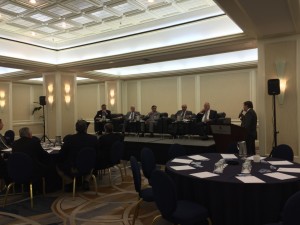The shortage in quality labor, the challenges to public-private partnerships and the viability of EB-5-funded projects were among the topics discussed at a forum covering civic and vertical construction on Thursday morning.
“Florida is such an active market. Maybe it’s the weather, maybe it’s South Beach, but it’s attracted a lot of new players,” panelist Ricardo Davila of American Global said at the American Global Inaugural Construction Forum at the Intercontinental Miami in downtown Miami.

Vertical construction panel at the Intercontinental Miami on Thursday.
Increased competition means that bidding for public-private partnerships, or P3s, is more challenging. Those projects range from infrastructure such as bridges and roads to convention centers and government office buildings.
AJ Meyer, project development specialist at Balfour Beatty, asked the panel when “enough is enough,” using the Miami-Dade’s Water & Sewer as an example. The department hasn’t issued any P3s since instituting a program “many years ago.”
“In Broward County, there have been two failed attempts to expand the convention center hotel and the convention center itself. So, [the county] starts off the process again and everyone said there would be no bids. Well, guess what? They had six proposals,” Percy Aguila, senior vice president at BankUnited, said during the panel. “There is always going to be someone else.”
Investing in the process includes educating public agencies on the partnerships, Davila said. “You’re paying for the education process,” he said. “Do I want to wait or do I want to get in early? Public agencies rely on ‘try and fail, try and fail.'”
Despite the time and money spent, P3s result in fewer, if any, construction failures, date-certain and dollar-certain contracts, and fewer changes during the process.
“The largest contract 10 years ago was $150 million, now it’s $800 million,” Davila said. “New players are going to come out, and low bidders are going to be there always.”
A shortage of quality construction labor was also a key takeaway from the event. During the last cycle, with “projects going up left and right, the quality of construction fell tremendously and construction defect claims were through the roof,” according to Stephen Reisman, vice chairman and co-managing partner of construction law firm Peckar & Abramson.
Reisman said the construction of condominium towers offers the highest risk in South Florida, followed by apartments. “There just isn’t enough skilled labor to meet the demand,” he said.
The challenge, he said, lies in negotiating the right contracts with developers. “How do we build off the lessons we’ve learned from the last cycle? When I drive into downtown Miami and look around, I ask myself, is this sustainable? Show me the money.”
Reisman also discussed the 50-percent buyer deposit structure. “It’s a good business plan. But what if it doesn’t work?” he asked. “If the demand falls off, people walk away. How are your contracts secured? Contractors have lien rights, and lien rights are typically second to financing.”
Moderator Michael Marino also asked about EB-5 funding for vertical projects.
“It has great promise, but hasn’t panned out,” Reisman said. “In the project we’ve invested in, the source of the funds is China — and what’s happened with the Chinese market recently has been devastating. Our recommendation has been, ‘don’t count on it.'”
